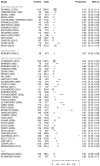Drug administration errors in hospital inpatients: a systematic review
- PMID: 23818992
- PMCID: PMC3688612
- DOI: 10.1371/journal.pone.0068856
Drug administration errors in hospital inpatients: a systematic review
Abstract
Context: Drug administration in the hospital setting is the last barrier before a possible error reaches the patient.
Objectives: We aimed to analyze the prevalence and nature of administration error rate detected by the observation method.
Data sources: Embase, MEDLINE, Cochrane Library from 1966 to December 2011 and reference lists of included studies.
Study selection: Observational studies, cross-sectional studies, before-and-after studies, and randomized controlled trials that measured the rate of administration errors in inpatients were included.
Data extraction: Two reviewers (senior pharmacists) independently identified studies for inclusion. One reviewer extracted the data; the second reviewer checked the data. The main outcome was the error rate calculated as being the number of errors without wrong time errors divided by the Total Opportunity for Errors (TOE, sum of the total number of doses ordered plus the unordered doses given), and multiplied by 100. For studies that reported it, clinical impact was reclassified into four categories from fatal to minor or no impact. Due to a large heterogeneity, results were expressed as median values (interquartile range, IQR), according to their study design.
Results: Among 2088 studies, a total of 52 reported TOE. Most of the studies were cross-sectional studies (N=46). The median error rate without wrong time errors for the cross-sectional studies using TOE was 10.5% [IQR: 7.3%-21.7%]. No fatal error was observed and most errors were classified as minor in the 18 studies in which clinical impact was analyzed. We did not find any evidence of publication bias.
Conclusions: Administration errors are frequent among inpatients. The median error rate without wrong time errors for the cross-sectional studies using TOE was about 10%. A standardization of administration error rate using the same denominator (TOE), numerator and types of errors is essential for further publications.
Conflict of interest statement
Figures





References
-
- About (2008) Medication Errors. The National Coordinating Council for Medication Error Reporting and Prevention; (NCC MERP). Available: http://www.nccmerp.org/aboutMedErrors.html . Accessed 2009 Sep 12 - PubMed
Publication types
MeSH terms
LinkOut - more resources
Full Text Sources
Other Literature Sources
Medical

